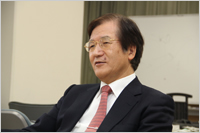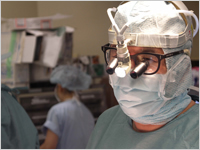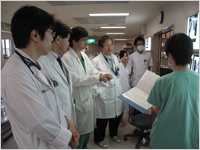Enlarge Image Professor Shunji Sano in the operating theatre
Enlarge Image Professor Shunji Sano during a ward round at Okayama University Hospital
Enlarge Image
Professor Shunji Sano
Department of Cardiovascular Surgery, Okayama University Graduate School of Medicine, Dentistry and Pharmaceutical Science:Benchmark for Surgical Treatment of Congenital Heart Disease.
Cardiovascular surgeon Professor Shunji Sano is Deputy Director of Okayama University Hospital and internationally renowned for his contributions to the surgical treatment of congenital heart disease including the 'Sano Procedure' for the hypoplastic left heart syndrome (HLHS)—"A Benchmark for the Surgical Treatment of Congenital Heart Disease".
"Breaking my arm when I fell out a tree and the fact that I had a weak body, were two childhood experiences that inspired me to become a doctor," says Professor Sano. "I do not regret my decision. I thoroughly enjoy my work in giving health and hope to children with heart problems."
After graduating from Okayama University Medical School, Professor Sano spent 8 years as a resident at two hospitals in Japan. "During my experience as a cardiovascular surgical resident in Japan, I wanted further experience as a cardiovascular surgeon in an international environment," explains Professor Sano. "So I looked for positions and in 1985, at the age of 32, accepted the post of Senior Fellow, Green Lane Hospital in Auckland, New Zealand. I was privileged to work with Sir Brian Barrett-Boyes, who invited to the hospital after I met him at a conference in Taiwan."
Sir Brain was a pioneer of cardiac surgery and one of the most famous cardiovascular surgeons in the world. Professor Sano says that he learnt a lot from Sir Brain and other staff at the hospital. "I experienced about 1400 heart operations during my two years at Green Lane. Much more than I would have been allowed to do at any hospital in Japan."
In 1987 Professor Sano moved to the Royal Children's Hospital at Melbourne University Medical School. "At Melbourne I worked with Roger Mee and his team," explains Professor Sano. "I consider Roger Mee to be my mentor and a great friend. A short time after arriving, I was made Consultant Cardiac Surgeon and Associate Professor at the hospital. During my stay in Green Lane and Royal Children's, I had a precious experience from Sir Brian and Roger Mee, who were the world's most renowned heart surgeons. I learned a lot from them and made lots of good friends during my oversea training.
Professor Sano returned to Okayama University in late 1990 and two years later was given a full professorship at the age of 40. "I was 13th on the list of candidates for the post," confides Professor Sano. "In 1995, Okayama university became the first cardiovascular surgical unit among the National universities in Japan to perform more than 200 cases in a year."
Professor Sano has maintained his passion for children's heart surgery with more than 7000 operations since his return, which have included innovative surgical procedures such as the total right ventricle exclusion procedure for isolated congestive right ventricle failure. "Since my return to Okayama, I have redesigned the hospital to standards of the foremost hospitals in the world," says Professor Sano. "I have also started research on cardiac regeneration therapy to treat severe congestive heart failure, where the patient's own stem cells are used to generate new heart cells. Also, I am working with Japan's JICA to go to other countries in Asia, such as Vietnam, to treat children with heart problems as well as teaching local surgeons in these countries some of my surgical procedures."
In February 2010, Professor Sano was invited to be the 19th honorary member of German association for Thoracic and cardiovascular surgery. In June 2012 Professor Sano was also invited to give the prestigious 24th Robert E. Gross-Memorial Lecture at the Harvard Medical School, Boston, USA. "I think that the invitation to give these two lectures recognizes the far-reaching contributions made by the medical staff at Okayama University Hospital and the University administrators for their support."



